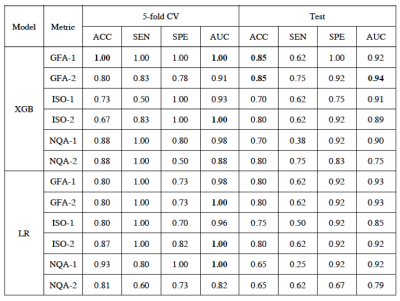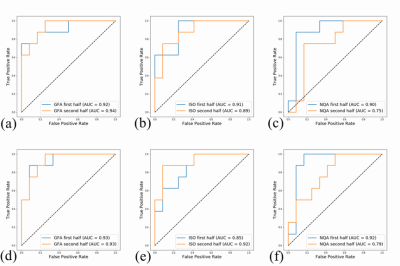1888
Predicting suicidal ideation from depressive patients using autoencoder machine-learning model with brain generalized q-sampling imaging1Department of Medical Imaging and Radiological Sciences, Chang Gung University, Taoyuan, Taiwan, 2Medical Imaging Research Center, Institute for Radiological Research, Chang Gung University and Chang Gung Memorial Hospital at Linkou, Taoyuan, Taiwan, 3Department of Psychiatry, Chang Gung Memorial Hospital, Chiayi, Taiwan, 4Department of Diagnostic Radiology, Chang Gung Memorial Hospital, Chiayi, Taiwan, 5Department of Counseling and Clinical Psychology, Columbia University, New York City, NY, United States, 6School of Medicine, Chang Gung University, Taoyuan, Taiwan
Synopsis
It is estimated that at least one million people die by suicide every year, showing the importance of suicide prevention and detection. An autoencoder and machine learning model was employed to predict people with suicidal ideation based on their brain structural imaging. Our results showed that the best pattern of structure across multiple brain locations can classify suicidal ideates from NS and HC with a prediction accuracy of 85%, a specificity of 100% and a sensitivity of 75%. The algorithms developed here might provide an objective tool to help identify suicidal ideation risk among depressed patients alongside clinical assessment.
Introduction
It is estimated that at least one million people die by suicide every year, showing the importance of suicide prevention and detection (1). In this study, an autoencoder and machine learning model was employed to predict people with suicidal ideation based on their brain generalized q-sampling imaging (GQI) (2).Methods
In our study, we recruited three groups of 153 participants: 41 depressive patients with suicidal ideation (SI) (age 21–60 years, mean = 42.17 years, SD = 11.85 years), 54 depressive patients without suicidal thoughts (NS) (age 21–60 years, mean = 46.17 years, SD = 9.86 years), and 58 healthy controls (HCs) (age 20–57 years, mean = 40.22 years, SD = 9.65 years). All participants were at least 20 years of age and right-handed. All participants were scanned using a 3 T MRI (Verio, SIEMENS, Germany) system with a single-shot, diffusion-weighted spin echo-planar imaging sequence. Diffusion images were obtained with TR/TE = 8943/115 ms, FOV = 250 × 250 mm2, matrix =128 × 128, slices = 35, in-plane resolution = 2 × 2 mm2, slice thickness = 4 mm, signal average = 1, and 192 noncollinear diffusion weighting gradient directions with b = 1000, 1500, 2000 s/mm2 and one null image without diffusion weighting (b = 0 s/mm2).In the GQI dataset, indices of generalized fractional anisotropy (GFA), isotropic values of the orientation distribution function (ISO), and normalized quantitative anisotropy (NQA) were separately trained in different machine learning models. A convolutional neural network (CNN)-based autoencoder model, the supervised machine learning algorithm extreme gradient boosting (XGB) and logistic regression (LR), were used to discriminate SI subjects from NS and HC subjects (3). After five-fold cross validation, separate data were tested to obtain the accuracy, sensitivity, specificity, and area under the curve of each result.
Results
The results of the supervised machine learning binary classification, distinguishing the ideation subjects from HCs and depression subjects via LR and XGB, are shown in Fig. 1. The results show the ACC (accuracy), SEN (sensitivity), SPE (specificity), and AUC of the 5-fold CV and testing set. As mentioned in the methods, the data from the HCs and depression subjects were combined and then split into halves. The two halves were separately distinguished from the ideation subjects and denoted as -1 (first half) or -2 (second half).ROC (receiver operating characteristic) curves of the test results having maximum AUCs are depicted in Fig. 2. Among the averaged results, the highest CV accuracy, 0.74, was attained via XGB-ISO-2. The highest CV AUC, 0.81, was attained via XGB-ISO-2. The highest testing accuracy, 0.73, was attained via XGB-GFA-1 and XGB-ISO-2. The highest testing AUC, 0.84, was obtained with XGB-ISO-2. Among the best results, the highest CV accuracy, 1.00, was attained via XGB-GFA-1. The highest CV AUC, 1.00, was attained via XGB-GFA-1, XGB-ISO-2, LR-GFA-2, LR-ISO-2, and LR-NQA-1. The highest testing accuracy, 0.95, was attained via XGB-GFA-1. The highest testing AUC, 0.97, was attained via XGB-ISO-2.
Discussion
To our knowledge, this is the first study using a machine learning algorithm based on the structural MRI to identify individuals with suicidal ideation. The results showed that the best pattern of structures across multiple brain locations can classify suicidal ideates from nonideation, depressed patients and healthy controls with a prediction accuracy of 85%, a specificity of 100% and a sensitivity of 75%.There are some strengths in the present study. First, we used several different machine learning methods to determine the more appropriate algorithm. Second, the diagnosis of depression was based on clinical assessment, and confirmation of suicidal ideation was based on both self-report and structural interviews. Third, we recruited both nondepressed and depressed control subjects to control for the effect of depression. The sample size is large compared to the only one previous study. Notwithstanding, this study had some limitations. Since different accuracies were obtained among the different methods tested, it may imply that more samples are warranted.
Conclusion
The results from the present study showed the good accuracy of a machine learning algorithm based on data from structural MRI, and it might provide an objective tool to help identify suicidal ideation risk among depressed patients alongside clinical assessment.Acknowledgements
This study was supported by the research programs NSC102-2314-B-182-068-MY3, MOST105-2314-B-182-028, and MOST106-2314-B-182-040-MY3, which were sponsored by the Ministry of Science and Technology, Taipei, Taiwan.References
1. Nock MK, Borges G, Bromet EJ, et al. Cross-national prevalence and risk factors for suicidal ideation, plans and attempts. The British journal of psychiatry: the journal of mental science 2008;192(2):98-105.
2. Yeh FC, Wedeen VJ, Tseng WY. Generalized q-sampling imaging. IEEE transactions on medical imaging 2010;29(9):1626-1635.
3. Pedregosa F, Varoquaux l, Gramfort A, et al. Scikit-learn: Machine Learning in Python. J Mach Learn Res 2011;12:2825-2830.
Figures

